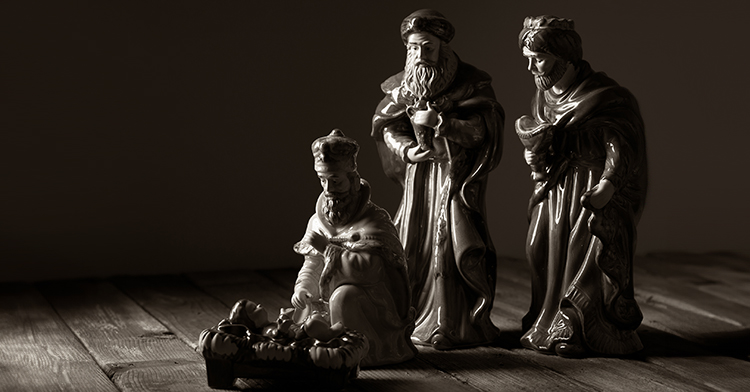As Christmas approached this year, my family began to gear up for the season, anticipating our unique traditions. My 12-year-old daughter wanted to know when we could watch our favorite Christmas movies. “After Thanksgiving,” I magisterially pronounced. She had an inexplicable hankering for “Holiday Inn.” I was secretly feeling a need for a full, adult-strength dose of “The Bishop’s Wife.”
My 8-year-old daughter wondered about the figurine of Santa Claus holding a coffee mug. It does not seem essential to my wife and me, but my daughter remembered it and wanted to see it again, positioned there on the corner of the mantel where it seasonally resides.
My son remembered I always bake an almond cake. I wondered: If I only use a little each year, is it safe to keep the bottle of extract?
My wife, too, brings annual expectations not to be set aside from her British childhood. To her, Christmas crackers are not food, but rather table decorations that pop with a little explosion and yield festive hats and jokes and tiny toys.
I am a historian who was raised determinedly low church. My Christian academic mentors taught me that various, vaguely-gestured-at Eastern cultures traditionally think of history as cyclical, but the Christian view of history is linear. There is an unfolding sequence of events that happen only once: creation, fall, redemption --- incarnation, death, resurrection.
Low church meant that, when I was growing up, the sermons on the Sunday before Christmas generally took the crucifixion as their theme. The atonement is the heart of the gospel, these preachers reasoned; why superstitiously follow mere church tradition and speak about the incarnation just because we are near Dec. 25? The great Baptist preacher C. H. Spurgeon compiled “The Interpreter,” a volume for daily family Bible readings. It follows a canonical order and thus the reading for Dec. 25 is from the Epistle of Jude.
What does it mean to say that Christmas time has come around again? Charles Taylor, in “A Secular Age,” evokes a medieval sense of time in which on this Christmas morn we are temporally closer to the very day when the Virgin Mary gave birth to her firstborn son and wrapped him in swaddling clothes than we are to last summer, when the mosquitoes tried to join our lazy, impromptu party with our neighbors on the back deck.
It is not easy to live linearly. We cannot help but be anxious about the unknown, and the greatest unknown is the future. Whatever the future holds we know it will involve unpredictable change, and change is often not easy or welcome even when it is ultimately for the better -- and we suspect it might not be this time.
Therefore God gave us the seasons so that we could know where we are -- a predictable annual cycle within the clouded linear sprawl. Even an 8-year-old can think to herself, “I have seen this before. I know what will happen next. It will involve goodwill on Earth and peace and salvation and Santa with a mug on the mantel. As the angel said, I need not be afraid.”
This is true in nature, of course -- and it is a gift from our Creator God. There is a time to plant and a time to harvest and therefore we always know where we are. Taylor follows a long line of sociologists and historians who argue that these connections have become increasingly severed in our disenchanted world. The Industrial Revolution disciplined us to be like machines that do the exact same things day after day, as it were, in season and out of season.
What I notice, however, is how much we resist this. I live in the suburbs, where all agrarian rhythms are meant to be obliterated -- the land of supermarkets where it is always strawberry-picking time. In truth, however, suburbanites still fly the flag for the changing seasons. Often literally so; the lady at the corner of our block has more than a half-dozen outdoor banners to tell us where we are in the year, from pastel flowers to harvest corn to the Christ child in the manger.
As in nature, so in salvation history. The Israelites knew where they were in the annual cycle because of the feasts that the Almighty had commanded them to keep: “This is a day you are to commemorate; for the generations to come you shall celebrate it as a festival to the Lord . . . Celebrate the Festival of Unleavened Bread, because it was on this very day that I brought your divisions out of Egypt.” (Exodus 12:14, 17) Salvation history is indeed linear, but our appropriation of it is cyclical.
My childhood church’s low Protestantism came from John Calvin, who thoroughly and resolutely abolished the Christian year: Calvin was the Grinch who stole Christmas. Perhaps a sociologist would say that he was the preacher who disenchanted the world. Fortunately, like the movie “Holiday Inn” and the almond cake, Christmas always finds a way to come back again.
Every year it insists on telling us again about how God became flesh and dwelt among us. It graciously allows us to learn once again where we are and who we are.
Yea, Lord, we greet Thee, born this happy morning. Christ our Savior, you have broken into our world, our lives, once again, and drawn close to us anew. On this day, Christmas 2009, we stand closest of all in time to a day two millennia ago when unto us a child was born.









